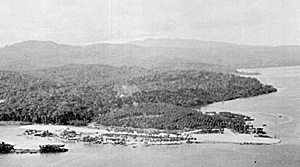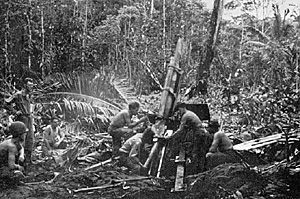
Segi Point
In the midst of these preparations, Admiral Turner received disquieting news about Segi Point, which was scheduled to furnish the Allies with an airfield.
AIRFIELD AT SEGI POINT, New Georgia.
Coastwatcher Donald Kennedy reported on 20 June that the Japanese were moving against his hideout and that he was heading for the hills. He requested help. (The remainder of this chapter is based on Halsey and Bryan, Admiral Halsey's Story, pp. 158-61; Craven and Cate, The Pacific: Cuadalcanal to Saipan, pp. 221-29; Morison, Breaking the Bismarcks Barrier, pp. 138-60; ONI USN, Operations in the New Georgia Area, PP. 9-23; History of the New Georgia Campaign, MS, 13 Aug 45, prepared by Hist Sec, G-2 SOPACBACOM, Vol. I, Chs. II-III,V, OCMH; after action rpts, jnls, int rpts, and hists of USAFISPA, NGOF, COMAIR New Georgia (2d Mar Air Wing), XIV Corps, I Mar Amphib Corps, 43d and 37th Divs, and subordinate units, and ist Mar Raider Regt; COMSOPAC, TF 31, and TF 33 War Diaries; 17th Army Operations, Vol. II, Japanese Monogr No. 40 (OCMH); 17th Army Operations, Map Supplement, Japanese Monogr No. 40A (OCMH); Southeast Area Naval Operations, Vol. II, Japanese Monogr No. 49 (OCMH); Outline of Southeast Area Naval Air Operations, Pt. IV, Japanese Monogr No. 108 (OCMH).)
Kennedy's report was correct. In early June a small Japanese force had gone to the southeast part of Vangunu to deal summarily with disaffected natives, and on 17 June half the 1st Battalion, 229th Infantry, under a Major Nagahara or Hara had moved from Viru Harbor southeast toward Segi Point.
As loss of Segi Point prior to D Day would deprive the Allies of a potential air base, Turner, a man of fiery energy and quick decision, abruptly changed his plans. He had originally intended to land the heavily reinforced ist Battalion, 103d Infantry, at Segi on 30 June to build the fighter field and establish a small naval base. But on receipt of Kennedy's call for aid, he hurriedly dispatched the handiest force available, the 4th Marine Raider Battalion (less N and Q Companies), from Guadalcanal in the fast destroyer-transports Dent and Waters to seize Segi and hold it. Ships and marines wasted no time. By 2030 of the same day-20 June-the ships were loaded and under way.
Before dawn next morning they had safely worked their way through Panga Bay, though both vessels scraped bottom in the reef and rockfilled waters. Kennedy, still safe, had lit bonfires on the beach and when the marines started ashore at 0550 he was there to meet them. There were no Japanese. The major and his men were still in the vicinity of Lambeti Village.
Next morning the APD's Schley and Crosby brought A and D Companies of the 103d Infantry and an airfield survey section to Segi Point. Though alerted several times against enemy attack, the Segi garrison was undisturbed until 30 June, when a series of Japanese air attacks made things lively. Construction of the airfield began on 30 June. Using bulldozers and power shovels, and working under floodlights at night, the Seabees of the 20th Naval Construction Battalion had the strip ready for limited operations as a fighter staging field by 11 July. ("The lighting of the airstrip at night was a carefully figured risk. We calculated we could get sufficient warning from our radar to turn off the lights before the attackers arrived." Ltr, Col Hundley to Gen Smith, Chief of Mil Hist, 19 Oct 53, no sub, OCMH.)
Wickham Anchorage
The force selected for the seizure of Wickham Anchorage by Vangunu Island was ready to sail from the Russells on 29 June.
 MEN OF 152D FIELD ARTILLERY BATTALION firing a 105-mm. howitzer in support of
Colonel Brown's 2d Battalion, 103d Infantry.
MEN OF 152D FIELD ARTILLERY BATTALION firing a 105-mm. howitzer in support of
Colonel Brown's 2d Battalion, 103d Infantry.
Commanded by Lt. Col. Lester E. Brown, the force included Colonel Brown's 2d Battalion, 103d Infantry, reinforced, and N and P Companies, plus a headquarters detachment, of the 4th Marine Raider Battalion. Under Admiral Fort aboard the Trever, the convoy consisted of the destroyer-transports Schley and McKean, carrying marines, and seven LCI's which bore soldiers. The ships cast off shortly after 1800 and set course for Oleana Bay, about two and one-half miles west by south from Vura village.
Allied scouting parties had reported that the main Japanese concentration at Wickham Anchorage--one platoon of the 229th Infantry and a company of the Kure 6th Special Naval Landing Force was near Vura, and had also reported that on the east shore of Oleana Bay a 500-yard-long strip of solid sand offered a good landing beach. It had therefore been decided to land the troops at Oleana Bay and then march overland and outflank the enemy positions from the west.
There were two trails from Oleana Bay to Wickham Anchorage. One, which followed the shore line, was believed used by the Japanese, but a shorter one had been cut farther inland in April by Kennedy's men in order to get scouts into the Vura area. This trail was thought to be unknown to the Japanese, and troops following native guides could be expected to cover it in five or six hours.
Visibility was practically nonexistent for the Wickham-bound convoy on the night of 29-30 June. Rain, lashed by a stiff wind, fell throughout the night, and continued as the vessels threaded their cautious way through the shoals and reefs into Oleana Bay. At 0335, 30 June, the ships hove to. Shortly afterward the first wave of marines began to debark from the destroyer-transports into LCVP's, a task complicated by darkness, rain, high wind, and heavy seas. Two LCVP's were almost loaded when the APD commanders discovered they were lying off the west rather than the east shore of the bay. The marines reboarded the destroyer-transports which then moved a thousand yards eastward.
Once More Into the Beach
Again the marines loaded into LCVP's and started for the beach, which was obscured by rain and mist. Beach flares which had been set by members of the scouting party were invisible. Only the noise of the breakers indicated the direction of the shore. But things got worse. As the first wave of LCVP's blindly made their way shoreward, the LCI's broke into the formation and scattered it.
Unable to reform, or even to see anything, the LCVP coxswains proceeded on their own. The result was exactly what might be expected from a night landing in bad weather. The assault wave of marines landed in impressive disorganization. Six LCVP's smashed up in the heavy surf that boiled over coral reefs. Fortunately, the Japanese were not present to oppose the landing. There were no casualties.
The LCI's, landing in daylight, found the proper beach, and by 0720 the Army troops were ashore. More marines had begun landing at o63o at the correct beach. With all landing operations concluded by l000, the ships departed.
Three officers of the reconnaissance party had met the landing force and informed Colonel Brown that the Japanese main strength was at Kaeruka rather than Vura. Once the scattered troops had been collected, the overland advance began with a small column moving toward Vura along the coastal trail while the main column marched against Kaeruka over Kennedy's trail. The marines and soldiers first met the enemy in early afternoon. Then ensued four days of fighting in the sodden jungles, with the Americans receiving support from dive bombers and warships, from their own heavy weapons, and from the 105-mm. howitzers of the 152d Field Artillery Battalion on the beach at Oleana Bay.
By the end of 3 July the Americans, having blasted the Japanese out of their entrenchments, were in complete possession of Wickham Anchorage. Many of the Japanese garrison had been killed; some escaped by barge, canoe, or on foot. In the seizure of this future staging point for landing craft, the marines lost twelve killed, twenty-one wounded. Army casualties are not listed.
Viru Harbor
When the Viru Occupation Force, the reinforced B Company, 103d Infantry, on board three destroyer-transports, sailed into Viru Harbor before daylight on 30 June, lookouts vainly scanned the shore line for a white parachute flare. This was to have signaled that the marine raider companies that landed at Segi Point had moved against Viru from inland and seized positions flanking the harbor, for it had been agreed that attempting to land the infantry in frontal assault against the high cliffs surrounding the harbor would be too risky.
But Lt. Col. Michael S. Currin, commanding the 4th Marine Raider Battalion, had warned that his overland march was going slowly and that he might not arrive and take the harbor by 30 June. Thus the destroyer-transports waited just outside the harbor, beyond range of a Japanese shore battery (Major Hara had left part of his battalion at Viru) and at noon went to Segi Point where with Turner's approval the troops went ashore. The attack force commander agreed that in view of the delay B Company should follow the marine raiders in their overland march.
Currin's men had begun the first leg of their twelve-mile advance from Segi Point to Viru Harbor in rubber boats on 27 June. They landed near Lambeti Plantation that night, and the next morning set out on their overland march. Skirmishes with the Japanese, coupled with the difficulty of walking through the jungle, slowed them down. They forded streams, knee-deep in mud and shoulderhigh in water. The leading elements of the column churned the trail into slippery ooze, so that the rear elements floundered and stumbled along. Thus it was evening of 30 June before the marines reached Viru Harbor, which they took handily the next day by a double envelopment supported by dive bombers that knocked out the Japanese shore battery. (According to Colonel Hundley, some naval vessels, apparently unaware of the postponement, sailed into Viru Harbor just as the bombing began. The Japanese manned the shore defenses, which were promptly knocked out, and were completely surprised by the marine attack. Ibid.)
On 4 July B Company, 103d, which had come up from Segi Point, took over the defenses of Viru Harbor from the marines.
Thus were the operations of the Eastern Force conducted, separately from each other and separately from those of the Western Force, but under Admiral Turner's general supervision in his capacity of attack force commander. They had provided one airfield and two staging bases. While important, they were undertaken only to support the seizure of Rendova by a substantial force, which was then to assault Munda and Vila.
More Toenails: The Landings in New Georgia
- South Pacific Organization
Preparation
Tactical Plans
Segi Point, Wickham Anchorage, and Viru Harbor
Battle Over Rendova
Move to Zanama and Rice Anchorage
Large Map of New Georgia Landings (slow: 135K)
Jumbo Map of New Georgia Landings (monstrously slow: 792K)
Back to Table of Contents -- Operation Cartwheel
Back to World War Two: US Army List of Issues
Back to MagWeb Magazine List
© Copyright 2002 by Coalition Web, Inc.
This article appears in MagWeb (Magazine Web) on the Internet World Wide Web.
Other military history articles and gaming articles are available at http://www.magweb.com